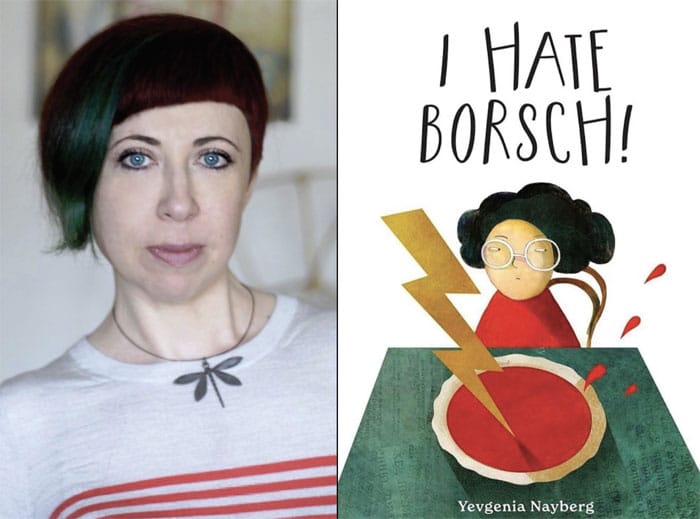 Author/Illustrator Yevgenia Nayberg
Photo by Anton Krasnov
Author/Illustrator Yevgenia Nayberg
Photo by Anton Krasnov Whether you love it or hate it, borsch is likely part of your Jewish cultural identity. And the version you eat has as much to do with where you are from as the ingredients you put into it.
For Yevgenia Nayberg, author and illustrator of the children’s picture book, “I Hate Borsch!” borsch is just a regular, familiar food that was part of her upbringing in Kyiv, Ukraine. It’s the same way many Americans feel about pizza.
“I do not hate borsch,” Nayberg said. “I come from a very strict Jewish household, so I don’t think I had many choices.”
More commonly spelled “borscht,” the soup’s name comes from the beetroots that give it the bright red color. The name is also used for a variety of sour-tasting soups without beetroots, such as sorrel-based green borscht, rye-based white borscht, and cabbage borscht.
While borsch, which evolved from an ancient soup, originally cooked from pickled stems, leaves and umbels of common hogweed, it’s important in Russian and Polish cuisines, with Ukraine is frequently cited as its place of origin.
“I Hate Borsch!” tells the story of a young girl who despises the beloved soup. When she emigrates to the United States, she tries a bunch of American food, but that leaves her feeling empty. After discovering borsch recipes in an old suitcase (departing gifts from all the grandmothers she knew in the Ukraine), she decides to give the soup another try.
Imaginatively illustrated with splashes of bright borsch red, “I Hate Borsch!” is a love letter to borsch that captures the complicated experience of rejecting and embracing one’s culture.
An award-winning illustrator, painter and set and costume designer, Nayberg’s other picture books include, “Anya’s Secret Society” (which came out in 2019 and received a Junior Library Guild Gold Selection Award), “Typewriter” and “Mona Lisa in New York.” Her illustrations have also appeared in magazines and on theater posters, music albums and book covers; her paintings, drawings and illustrations are held in private collections worldwide.
Nayberg, 47, moved to the United States in 1994, first to Pittsburgh, then to Los Angeles for 10 years. She moved to New York City 17 years ago, where she hopes to remain.
“I come from the Soviet Jews,” she said. “Most of us, of course, are very secular, because we really didn’t have any opportunity to practice. Many people hid their religious affiliation.”
She continued, “I feel very Jewish. Maybe not religiously Jewish, but very culturally Jewish. [I relate to the] Jewish sense of humor and the irony. And, of course, the food.”
Unlike her young character, Nayberg was 19 when she moved to the States.
”I did not want to write a book about borsch. I wanted to write a book about the foods that I came to taste when I came to America.” – Yevgenia Nayberg
“I did not want to write a book about borsch,” she said. “I wanted to write a book about the foods that I came to taste when I came to America.”
Nayberg polled her immigrant friends about what they found weird about American foods. Eventually, the American foods, including the peanut butter and jelly sandwich), were all reduced to one page, and somehow it became the borsch book.
“What I think is autobiographical in this book is mostly just the voice,” Nayberg said. “If any of my books capture my own personal voice – how I speak and how I see the world – this is it.”
Nayberg thinks “I Hate Borsch!” is a good book for learning how to be at peace with your identity. Many young immigrants come to the U.S. and are happy to be like everybody else. They may even try to reject or suppress that cultural identity, like her character did.
The author hopes her book encourages people to dig out their identity, see it in a new light and come to terms with it. She also wants readers will try her beloved borsch recipe.
From “I Hate Borsch!”
There are as many borsch recipes as there are Ukrainian grandmas. And don’t even get me started on the neighboring countries of Eastern Europe and their borsch recipes!
There is hot borsch and cold borsch, one with beans and another one with beef. There’s a version with prunes, and one with mushrooms. There’s even green borsch, which I refuse to discuss here.
It takes courage to share a borsch recipe. What would the grandmas think? And yet, I am going to do it.
This version of mine is vegan, at least until you add sour cream to your bowl at the end. (It is vegan by its nature, not because I removed some delicious ingredients.)
Yevgenia’s Vegetarian Borsch
Get the tiniest head of green cabbage you can find. Slice it in half and save another half for the time you decide to make some sauerkraut.
Roast and grate 4 small beets. (You can cheat and buy the scary-looking vacuum pack of ready-to-eat beets if you want.)
Peel and quarter 3 medium potatoes. Peel and grate 3 medium carrots.
Heat some neutral oil, like grapeseed or canola, in a large pot and drop the potatoes in. Let them get a bit of a tan and drop in the carrots. Stir from time to time to make sure they don’t burn.
Once they soften and brown a bit, fill the pot with boiling water, add a generous pinch of salt, and a whole peeled onion. Important: now is the time to add a pinch of sour salt. Sour salt is another name for citric acid. You can find it at most supermarkets. Skip this step and end up with sad, brown borsch.
Next, add a heaping tablespoon of tomato paste. Drop in the grated beets, bring the borsch to a boil, then cover the pot and let it simmer for at least 30 minutes. I like to simmer for an hour.
While this is happening, slice the cabbage as thinly as humanly possible. Bring the borsch back to a boil and drop the cabbage in. Stir and turn the heat off immediately. This way the cabbage will retain some bite to it. Don’t let it turn into a mushy mess!
Fish out and discard the onion. Crush a clove of garlic into the pot.
Ladle borsch into a bowl, add some sour cream, and sprinkle with fresh dill.
Any borsch will taste better the next day.
If this does not sound like the borsch your grandma makes, I apologize. I am sure she is a wonderful lady and a great cook.
Nevertheless, I stand by my borsch — as an artist, an omnivore and a dual citizen.























 More news and opinions than at a Shabbat dinner, right in your inbox.
More news and opinions than at a Shabbat dinner, right in your inbox.